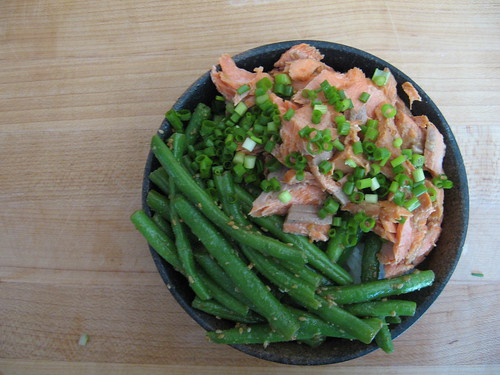When I was growing up, my family spent every summer visiting my grandparents in Washington and Oregon. Growing up in Alaska, the quality of our produce relied on the vagaries of the few airlines that came into the city. The Pacific Northwest, however, benefits from abundant winter rains and long hours of sun (or at least daylight) in the summer months.
Weeks were whiled away at my grandparents' house in Eugene, watching enough television at night to last my sister and I through the rest of the year, and passing the day having water fights, playing in the sprinklers, and being put to work by my grandma in the garden.
Even as a small child, I loved working (or, to my mind, playing) in the garden. My grandma took advantage of her large yard, growing an abundance of vegetables—for every tomato or zucchini plant that was planted each spring, she would experiment with something new. Romanesco was tried and added to the regular rotation; eggplants were discarded as not worth the effort. While I loved shoveling up potatoes and plucking crimson tomatoes from their vines, not everything was fun—I developed an irrational fear of artichokes for years after several ants crawled out of one onto my hand. Without a doubt, my favorite time to visit was late June, when both strawberries and green beans would be coming into season.
Eating as many strawberries as I could stomach was fun; making the rest into jam or tart fruit leather was like a special treat. None of that could compare, gardener protégé that I was, to snapping and canning green beans. My grandma must have canned 50 quarts of green beans every summer, all from one row of the garden, and if we had come to visit, we were all put to work.
I would go outside with the big stock pot, picking beans until my back ached and my neck was sunburnt. The pot brimming, we would lug it up to the patio. Three generations, my grandma and mom in chairs, my sister and I on the steps, would sit around the pot, grabbing handfuls of beans and snapping them with that satisfying "pop" into an even bigger bowl. I would take a few tentative bites of the raw bean—even now, when I can use that bite to gauge the freshness and ripeness of a bean, I still don't particularly enjoy it. The quarts would be packed and set in the pressure canner (still not something I've ventured to play with on my own), then set in rows along the kitchen counter to cool. Without room to work in the kitchen, our dinner that night would be cooked by my grandpa out on the grill—with green beans, of course, on the side.
For years green beans were my exception to the rule—I preferred them soft and cooked nearly into oblivion (or "Southern-style", as I was told once), like they were when canned, then reheated on the stove months later. However, in recent years, I have begun cooking my green beans quickly. My most common method is from Marcella Hazan: the beans are tipped, then boiled in salted water until just tender throughout, 3-5 minutes; they are then drained, spread out to cool quickly, and tossed immediately in olive oil with lemon juice, salt, and some coarsely ground pepper.
Last night I decided to do something different. I had thawed a Sockeye salmon fillet the night before, and I suddenly decided that I wanted to do a broiled, miso-glazed salmon instead of my typical nearly-naked salmon, seared with nothing more than salt and pepper. That inspiration encouraged me to do a quick google search, and half an hour later, I sat down to salmon, rice, and toasted sesame green beans.
Toasted Sesame Green Beans
1 tablespoon white sesame seeds
1 lb green beans, preferably Blue Lake
2 teaspoons mirin (Japanese sweet rice wine)
2 teaspoons soy sauce
1 teaspoon vegetable oil
2 teaspoons toasted sesame oil
In a dry wok, toast the sesame seeds over medium heat, stirring regularly, until very fragrant and golden-brown, about 4-5 minutes. Transfer to a bowl or mortar and let cool.
Set a large pot of water to boil. Meanwhile, rinse the beans and snap the tips off; if the beans are very large, break into two pieces. When the water is boiling, salt it and carefully add the beans. Cook until just nearly tender, about 3 minutes.
Meanwhile, set aside a pinch of seeds for garnish and crush the rest into a rough paste with a pestle or wooden spoon. Transfer to a small bowl and add the mirin and soy sauce and stir well to blend.
When the beans are cooked, drain them and soak briefly in cold water to stop the cooking; drain. Reheat the wok over medium-high heat and add the two oils. When the wok is hot but not quite smoking, add the drained beans. Cook 2-3 minutes, stirring regularly, until hot all the way through. Add the sesame paste mixture, stir well to blend, and cook 1-2 minutes more—the beans should be cooked through but still a little bit crunchy. Sprinkle with the reserved sesame seeds and serve hot (or at room temperature, some people say, but I'm not okay with that).
Serves 3-4



These posts are my very favorite. Or favourite, whichever you prefer. It takes me back. I can't wait until I get green beans in my CSA basket this year. Until then, I'll give it a shot with frozen.
ReplyDelete